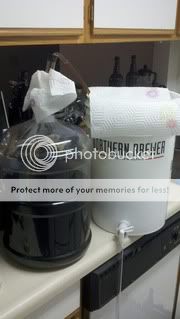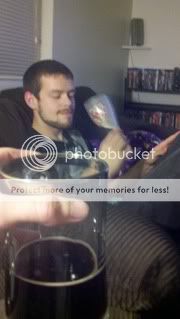It's been two weeks since my last confession... Ha. Two weeks ago, my secondary fermentation ended for the Leviathan Rye Stout. The recipe kit recommended that after two weeks of primary fermentation, I move to two weeks of bottling to carbonate the beer and finish it up. I decided to do one week of primary fermentation and one week of secondary fermentation. Bottling beer is the most labor intensive portion of the beer-making process. It's not hard, just very tedious.
I took my SG reading and the beer was at 1.014, very close to the previous reading before the secondary fermentation. You can barely see it in these pictures, but the beer was dark but I could see through it. Very nice! My secondary fermentation worked. It also tasted just like beer. Granted, it was flat, warm beer but beer nonetheless. Yes, yes my sweet! It's almost time!!!!!
I mixed up 5 gallons of sanitizer and filled all 48 bottles with the sanitizer. Note the towel... This was critical. I cannot suggest enough to have a towel on your floor. Bottling makes a mess. To bottle I use a bottle-filler (http://www.northernbrewer.com/shop/fermtech-bottle-filler.html), which is a 3/8" diameter tube that is connected to a plastic hollow rod. At the end of the rod is a little plastic tab that extends below the rod, and when you set the rod down on end, the tab is pressed up, opening the hollow rod allowing gravity to pull the liquid into the bottle. When you lift the rod up, the tab falls and beer stops flowing into the bottle. Easy, right? Sort of. Every time I tried to use the bottle-filler, the little tab would stick and I'd be spraying sanitizer all over the kitchen like a tiny, malicious, profanity-spewing elephant.
"Flat beer is bad, mmkay?"
I ran into a few problems along the way. Siphoning really only works as long as the fluid being siphoned is above the fluid it's being siphoned in to. Maybe it's not really that way, but it's how it worked for me. Every little while, the levels of beer in each container would equal out and the siphoning would essentially come to a halt. I finally had to move the bottling bucket towards the ground, suspended on a P.O.S. bin that I was hoping wouldn't crack and break, spilling the sweet, alcoholic, elixir of life I had been making all over my kitchen. Probably would have ruined my night. And by probably, I mean I would have cried and resentfully cleaned up my mess, wiping my tears with beer-soaked towels. Fortunately, the bin held up and the beer was siphoned successfully.
Then came the process of painstakingly emptying each bottle of sanitizer, filling the bottle with beer and capping it. I decided to do this in a conveyor-belt style method. I sanitized the bottle caps during the other sanitizing steps, so everything was ready to go. I'd empty a 6-pack of the sanitized bottles, filling each one with beer with my left hand while my right hand emptied another bottle full of sanitizer into the sink. Then after all 6 bottles were done, I'd simply cover the bottle tops with the caps and move on to the next 6-pack. Again, while this sounds simple, the process resulted in 48 bottles of beer, but probably 1/8 of a gallon of beer slung around the kitchen as the gravity bottle filler would randomly spite me and spew flat, warm Leviathan stout all over the place. But, when all was said and done, I had my 2 cases of beer bottled, capped and set away to bottle ferment for 2 weeks...
Just a bit of a side note. When you bottle, if you end up doing all of this, and you use cardboard 6-pack holders... Wet cardboard is NOT great for support. I know this, and my guess is most of the people reading this post know this, but I decided to use them anyways. The 20 foot walk from my kitchen to the bathroom (Again, CLEAN!!!!) where I keep the bottles in case of explosion was very precarious.
Another side note - pay attention to how much sugar is added to the mixture before bottling, and pay attention to how much of the mixture you put in each bottle. If you're not careful you could end up with 48 little carbonated, beer-filled glass hand grenades. Just a thought...
Flash forward to 1 week ago. I decided that patience was not my strongest virtue and, you know, I needed to make sure my beer was progressing correctly... There weren't any bubbles in the bottles!!!! This is totally normal, as you've sealed off the bottles and the fermentation that is occurring is minimal. Coke and Pepsi aren't bubbly until you open the bottle and introduce air, allowing the gas exchange. Same concept here. I cracked open a beer for myself and one for Joe, my roommate. Ignore his face in the first picture. I didn't tell him I was taking a picture and really was trying to JUST get the beer first, but camera phones aren't great and the lighting in our place wasn't stellar. The second one was a better, even though he was hamming it up!
It tasted great! It was warm, but the carbonation was coming along nicely. Tomorrow is the two week mark. Beer time!
Something wicked this way comes...







